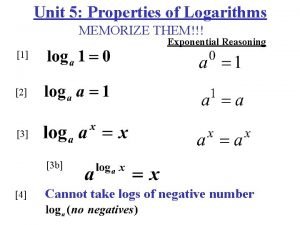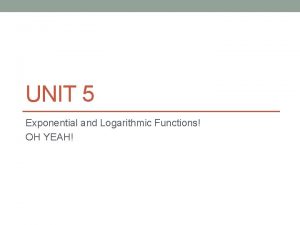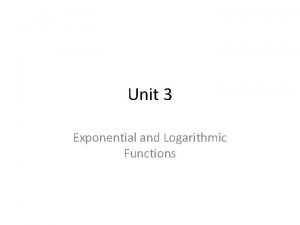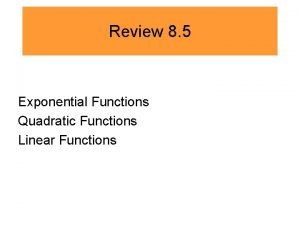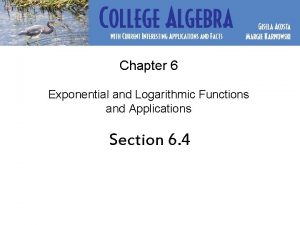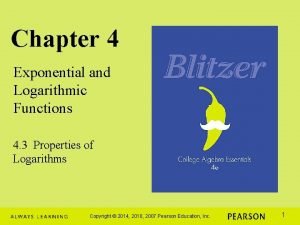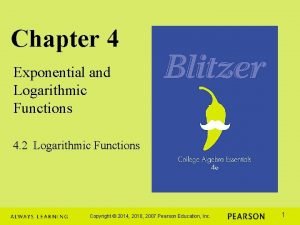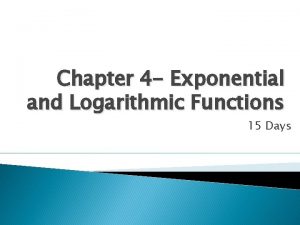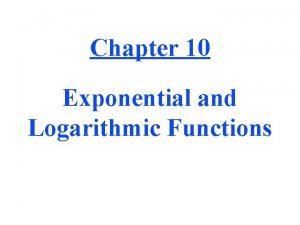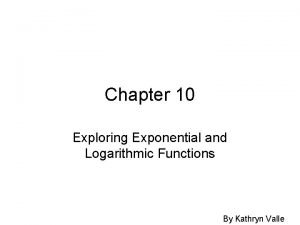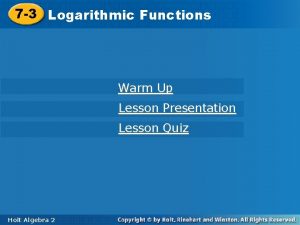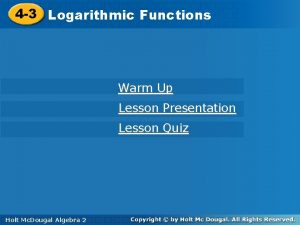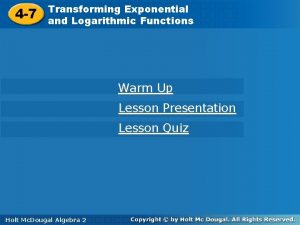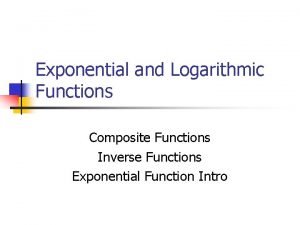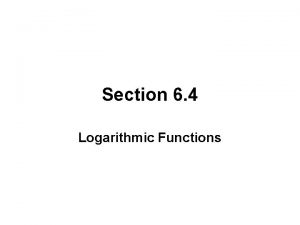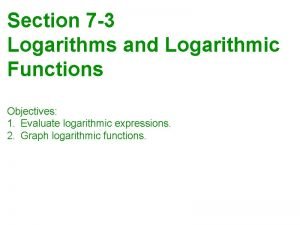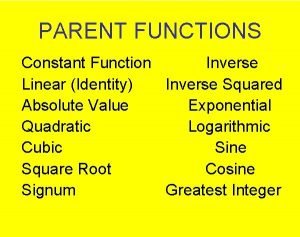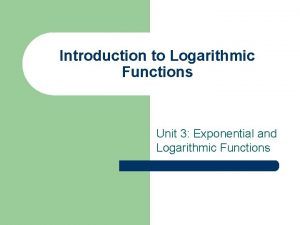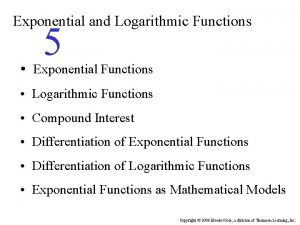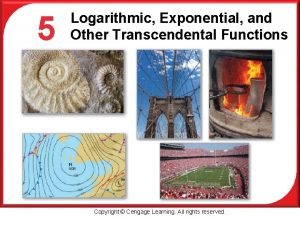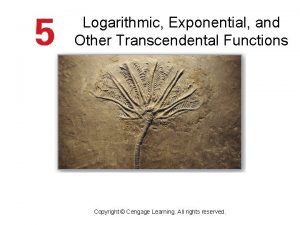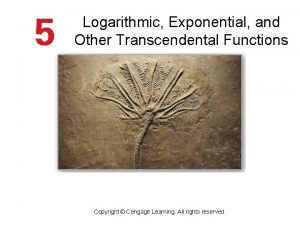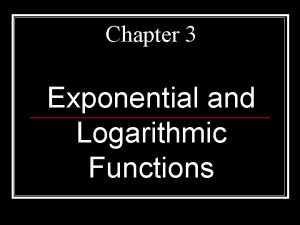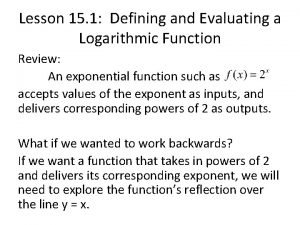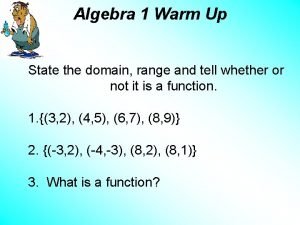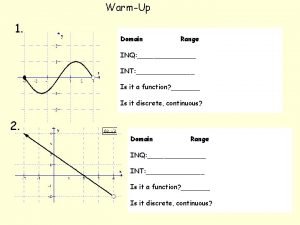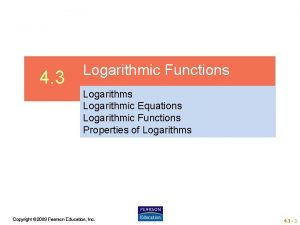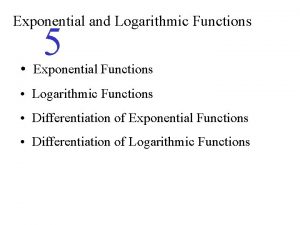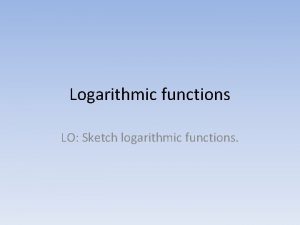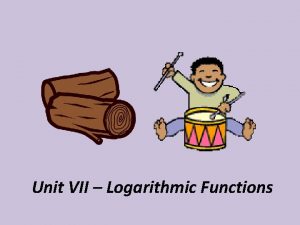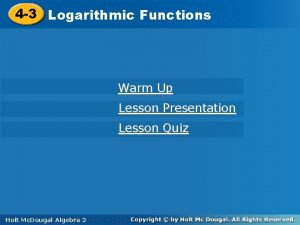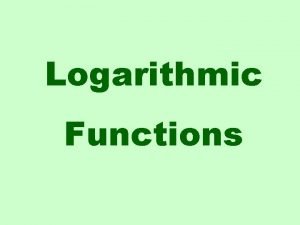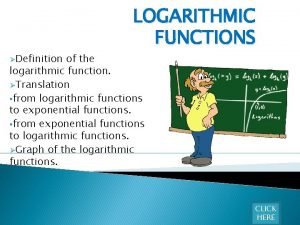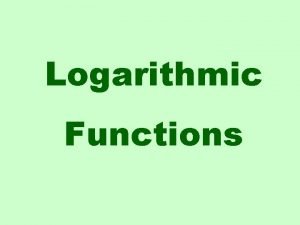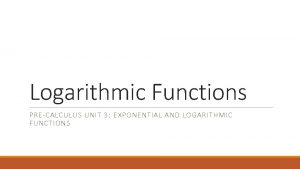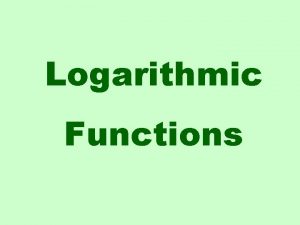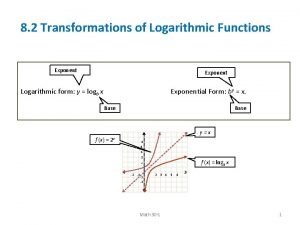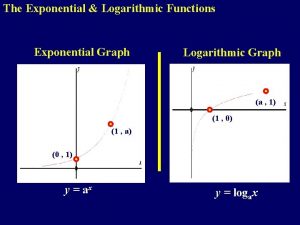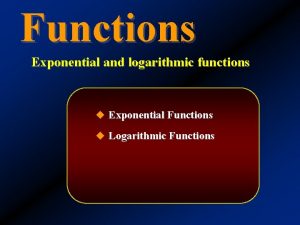4 3 Logarithmic Functions Warm Up Lesson Presentation

































- Slides: 33

4 -3 Logarithmic. Functions Warm Up Lesson Presentation Lesson Quiz Holt. Mc. Dougal Algebra 2 Holt

4 -3 Logarithmic Functions Warm Up Use mental math to evaluate. 1. 4– 3 3. 10– 5 2. 0. 00001 2 4. 5. A power has a base of – 2 and exponent of 4. Write and evaluate the power. (– 2)4 = 16 Holt Mc. Dougal Algebra 2

4 -3 Logarithmic Functions Objectives Write equivalent forms for exponential and logarithmic functions. Write, evaluate, and graph logarithmic functions. Holt Mc. Dougal Algebra 2

4 -3 Logarithmic Functions Vocabulary logarithm common logarithmic function Holt Mc. Dougal Algebra 2

4 -3 Logarithmic Functions How many times would you have to double $1 before you had $8? You could use an exponential equation to model this situation. 1(2 x) = 8. You may be able to solve this equation by using mental math if you know 23 = 8. So you would have to double the dollar 3 times to have $8. Holt Mc. Dougal Algebra 2

4 -3 Logarithmic Functions How many times would you have to double $1 before you had $512? You could solve this problem if you could solve 2 x = 8 by using an inverse operation that undoes raising a base to an exponent equation to model this situation. This operation is called finding the logarithm. A logarithm is the exponent to which a specified base is raised to obtain a given value. Holt Mc. Dougal Algebra 2

4 -3 Logarithmic Functions You can write an exponential equation as a logarithmic equation and vice versa. Reading Math Read logb a= x, as “the log base b of a is x. ” Notice that the log is the exponent. Holt Mc. Dougal Algebra 2

4 -3 Logarithmic Functions Example 1: Converting from Exponential to Logarithmic Form Write each exponential equation in logarithmic form. Exponential Equation Logarithmic Form 35 = 243 log 3243 = 5 1 2 25 = 5 log 255 = 104 = 10, 000 log 1010, 000 = 4 6– 1 = 1 6 ab = c Holt Mc. Dougal Algebra 2 log 6 1 6 = – 1 logac =b The base of the exponent becomes the base of the logarithm. The exponent is the logarithm. An exponent (or log) can be negative. The log (and the exponent) can be a variable.

4 -3 Logarithmic Functions Check It Out! Example 1 Write each exponential equation in logarithmic form. Exponential Equation Logarithmic Form a. 9 = 81 log 981 = 2 The base of the exponent becomes the base of the logarithm. b. 33 = 27 log 327 = 3 The exponent of the logarithm. logx 1 = 0 The log (and the exponent) can be a variable. 2 0 c. x = 1(x ≠ 0) Holt Mc. Dougal Algebra 2

4 -3 Logarithmic Functions Example 2: Converting from Logarithmic to Exponential Form Write each logarithmic form in exponential equation. Logarithmic Form Exponential Equation 1 log 99 = 1 9 =9 log 2512 = 9 29 = 512 log 82 = log 4 1 16 1 3 = – 2 logb 1 = 0 Holt Mc. Dougal Algebra 2 The base of the logarithm becomes the base of the power. The logarithm is the exponent. 1 3 8 =2 4 – 2 = 1 16 b 0 = 1 A logarithm can be a negative number. Any nonzero base to the zero power is 1.

4 -3 Logarithmic Functions Check It Out! Example 2 Write each logarithmic form in exponential equation. Logarithmic Form Exponential Equation log 1010 = 1 101 = 10 log 12144 = 2 122 = 144 log 8 = – 3 1 2 Holt Mc. Dougal Algebra 2 1 2 – 3 =8 The base of the logarithm becomes the base of the power. The logarithm is the exponent. An logarithm can be negative.

4 -3 Logarithmic Functions A logarithm is an exponent, so the rules for exponents also apply to logarithms. You may have noticed the following properties in the last example. Holt Mc. Dougal Algebra 2

4 -3 Logarithmic Functions A logarithm with base 10 is called a common logarithm. If no base is written for a logarithm, the base is assumed to be 10. For example, log 5 = log 105. You can use mental math to evaluate some logarithms. Holt Mc. Dougal Algebra 2

4 -3 Logarithmic Functions Example 3 A: Evaluating Logarithms by Using Mental Math Evaluate by using mental math. log 0. 01 10? = 0. 01 The log is the exponent. 10– 2 = 0. 01 Think: What power of 10 is 0. 01? log 0. 01 = – 2 Holt Mc. Dougal Algebra 2

4 -3 Logarithmic Functions Example 3 B: Evaluating Logarithms by Using Mental Math Evaluate by using mental math. log 5 125 5? = 125 The log is the exponent. 53 = 125 Think: What power of 5 is 125? log 5125 = 3 Holt Mc. Dougal Algebra 2

4 -3 Logarithmic Functions Example 3 C: Evaluating Logarithms by Using Mental Math Evaluate by using mental math. log 5 1 5 5? = 1 5 – 1 5 = 1 log 5 5 The log is the exponent. 1 5 Think: What power of 5 is 1 ? 5 = – 1 Holt Mc. Dougal Algebra 2

4 -3 Logarithmic Functions Check It Out! Example 3 a Evaluate by using mental math. log 0. 00001 10? = 0. 00001 The log is the exponent. 10– 5 = 0. 01 Think: What power of 10 is 0. 01? log 0. 00001 = – 5 Holt Mc. Dougal Algebra 2

4 -3 Logarithmic Functions Check It Out! Example 3 b Evaluate by using mental math. log 250. 04 25? = 0. 04 The log is the exponent. 25– 1 = 0. 04 Think: What power of 25 is 0. 04? log 250. 04 = – 1 Holt Mc. Dougal Algebra 2

4 -3 Logarithmic Functions Because logarithms are the inverses of exponents, the inverse of an exponential function, such as y = 2 x, is a logarithmic function, such as y = log 2 x. You may notice that the domain and range of each function are switched. The domain of y = 2 x is all real numbers (R), and the range is {y|y > 0}. The domain of y = log 2 x is {x|x > 0}, and the range is all real numbers (R). Holt Mc. Dougal Algebra 2

4 -3 Logarithmic Functions Example 4 A: Graphing Logarithmic Functions Use the x-values {– 2, – 1, 0, 1, 2}. Graph the function and its inverse. Describe the domain and range of the inverse function. f(x) = 1. 25 x Graph f(x) = 1. 25 x by using a table of values. x – 2 – 1 0 1 2 f(x) = 1. 25 x 0. 64 0. 8 1 1. 25 1. 5625 Holt Mc. Dougal Algebra 2

4 -3 Logarithmic Functions Example 4 A Continued To graph the inverse, f– 1(x) = log 1. 25 x, by using a table of values. x 0. 64 0. 8 1 f– 1(x) = log 1. 25 x – 2 – 1 0 1. 25 1. 5625 1 2 The domain of f– 1(x) is {x|x > 0}, and the range is R. Holt Mc. Dougal Algebra 2

4 -3 Logarithmic Functions Example 4 B: Graphing Logarithmic Functions Use the x-values {– 2, – 1, 0, 1, 2}. Graph the function and its inverse. Describe the domain and range of the inverse function. 1 2 f(x) = x Graph f(x) = 12 x by using a table of values. x f(x) =( 1 2 ) x – 2 – 1 0 1 2 4 2 1 1 2 1 4 Holt Mc. Dougal Algebra 2

4 -3 Logarithmic Functions Example 4 B Continued To graph the inverse, f– 1(x) = log 1 x, by using a table of 2 values. x f – 1(x) =log 1 2 x 4 2 1 – 2 – 1 0 1 2 1 1 4 2 The domain of f– 1(x) is {x|x > 0}, and the range is R. Holt Mc. Dougal Algebra 2

4 -3 Logarithmic Functions Check It Out! Example 4 Use x = – 2, – 1, 1, 2, and 3 to graph . Then graph its inverse. Describe the domain and range of the inverse function. Graph by using a table of values. x f(x) = 3 x 4 – 2 – 1 1 2 3 16 9 4 3 3 4 9 16 27 64 Holt Mc. Dougal Algebra 2

4 -3 Logarithmic Functions Check It Out! Example 4 To graph the inverse, f– 1(x) = log 3 x, by 4 using a table of values. x 16 9 4 3 3 4 9 16 27 64 f– 1(x) = log 3 x – 2 – 1 1 2 3 4 The domain of f– 1(x) is {x|x > 0}, and the range is R. Holt Mc. Dougal Algebra 2

4 -3 Logarithmic Functions Helpful Hint The key is used to evaluate logarithms in base 10. inverse of log. Holt Mc. Dougal Algebra 2 is used to find 10 x, the

4 -3 Logarithmic Functions Example 5: Food Application The table lists the hydrogen ion concentrations for a number of food items. Find the p. H of each. Substance H+ conc. (mol/L) Milk 0. 00000025 Tomatoes 0. 0000316 Lemon juice 0. 0063 Holt Mc. Dougal Algebra 2

4 -3 Logarithmic Functions Example 5 Continued Milk The hydrogen ion concentration is 0. 00000025 moles per liter. p. H = –log[H+ ] p. H = –log(0. 00000025) Substitute the known values in the function. Use a calculator to find the value of the logarithm in base 10. Press the key. Milk has the p. H of about 6. 6. Holt Mc. Dougal Algebra 2

4 -3 Logarithmic Functions Example 5 Continued Tomatoes The hydrogen ion concentration is 0. 0000316 moles per liter. p. H = –log[H+ ] p. H = –log(0. 0000316) Substitute the known values in the function. Use a calculator to find the value of the logarithm in base 10. Press the key. Tomatoes have the p. H of about 4. 5. Holt Mc. Dougal Algebra 2

4 -3 Logarithmic Functions Example 5 Continued Lemon juice The hydrogen ion concentration is 0. 0063 moles per liter. p. H = –log[H+ ] p. H = –log(0. 0063) Substitute the known values in the function. Use a calculator to find the value of the logarithm in base 10. Press the key. Lemon juice has the p. H of about 2. 2. Holt Mc. Dougal Algebra 2

4 -3 Logarithmic Functions Check It Out! Example 5 What is the p. H of iced tea with a hydrogen ion concentration of 0. 000158 moles per liter? The hydrogen ion concentration is 0. 000158 moles per liter. p. H = –log[H+ ] p. H = –log(0. 000158) Substitute the known values in the function. Use a calculator to find the value of the logarithm in base 10. Press the key. Iced tea has the p. H of about 3. 8. Holt Mc. Dougal Algebra 2

4 -3 Logarithmic Functions Lesson Quiz: Part I 1. Change 64 = 1296 to logarithmic form. log 61296 = 4 2. Change log 279 = 2 3 to exponential form. 27 2 3 Calculate the following using mental math. 3. log 100, 000 5 4. log 648 0. 5 5. log 3 1 – 3 27 Holt Mc. Dougal Algebra 2 =9

4 -3 Logarithmic Functions Lesson Quiz: Part II 6. Use the x-values {– 2, – 1, 0, 1, 2, 3} to graph f(x) =( 54 )X. Then graph its inverse. Describe the domain and range of the inverse function. D: {x > 0}; R: all real numbers Holt Mc. Dougal Algebra 2
 Unit 8 review logarithms
Unit 8 review logarithms 5 properties of logarithms
5 properties of logarithms Exponential and logarithmic functions unit test
Exponential and logarithmic functions unit test Logarithm to exponential form
Logarithm to exponential form What kind of pattern
What kind of pattern Chapter 6 exponential and logarithmic functions answers
Chapter 6 exponential and logarithmic functions answers Logarithmic rules
Logarithmic rules Chapter 4 exponential and logarithmic functions
Chapter 4 exponential and logarithmic functions Chapter 4 exponential and logarithmic functions answer key
Chapter 4 exponential and logarithmic functions answer key Pert formula
Pert formula Property of equality for exponential functions
Property of equality for exponential functions 7-3 logarithms and logarithmic functions answers
7-3 logarithms and logarithmic functions answers Integral of an exponential
Integral of an exponential 4-3 logarithmic functions answers
4-3 logarithmic functions answers Transforming exponential and logarithmic functions
Transforming exponential and logarithmic functions The inverse of exponential function is a composite function
The inverse of exponential function is a composite function Lesson 5-2
Lesson 5-2 Expanding logarithims
Expanding logarithims Chapter 9 exponential and logarithmic functions answer key
Chapter 9 exponential and logarithmic functions answer key Chapter 9 exponential and logarithmic functions answer key
Chapter 9 exponential and logarithmic functions answer key Chapter 5 exponential and logarithmic functions answer key
Chapter 5 exponential and logarithmic functions answer key 7-3 logarithms and logarithmic functions
7-3 logarithms and logarithmic functions Parent function of a square root
Parent function of a square root Introduction to logarithmic functions
Introduction to logarithmic functions Logarithm
Logarithm Transcendental functions examples with solutions
Transcendental functions examples with solutions Solving exponential and logarithmic functions calculator
Solving exponential and logarithmic functions calculator Logarithmic exponential and other transcendental functions
Logarithmic exponential and other transcendental functions Integration of exponential
Integration of exponential Chapter 5 exponential and logarithmic functions
Chapter 5 exponential and logarithmic functions Chapter 3 exponential and logarithmic functions
Chapter 3 exponential and logarithmic functions Lesson 15-1 defining and evaluating a logarithmic function
Lesson 15-1 defining and evaluating a logarithmic function Warm up domain range and functions
Warm up domain range and functions What is the domain and range of the function
What is the domain and range of the function

